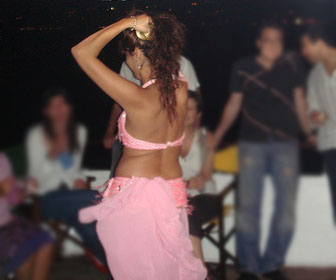 |
 |
| |
|
| |
BELLY DANCING

|
| |
 |
Get Flash to see this Video.
Version 8 and above required to view videos
|
|
| |
|
|
| |
|
|
| |
The earliest evidence of belly dancing is found in
Mesopotamia. Dating back to 1000 B.C., engravings on temple walls
depicting dancers have been discovered in Greece and Egypt. Thought
to be originally part of ancient fertility rituals, priestesses
would perform these dances as they invoked the goddesses'
intervention in the lives of their subjects.
There were two classes of dancers, each with its' own method and
style of dance. The Ghawazee or gypsy dancers were most often
uneducated and untrained street performers. Dancers of a more
respected class were the Awalim. Not only were these Almeh women
more cultured and trained in dance, but they could also recite
poetry and play musical instruments. Because of the veiling of the
women and the separation of the sexes, customs predating Islam,
traditional belly dances were performed by women for other women.
Only later did the lower class Gypsy dancers decide to make money by
dancing for soldiers, merchants and travelers.
Middle Eastern Dancing was introduced to the western world during
the 1890's at the world's fair. Because in that Victorian age, even
the term "belly-dancing" was perceived to be provocative or risque,
the dancers who performed there were dressed in plain floor-length
dresses, a strip of fabric tied around their hips. The beautiful
costumes associated with belly dancing today have evolved from a mix
of old world tradition and Hollywood glamour. Bare midriffs and low,
hip hugging belts show off the intricate body movements to a greater
degree.
Originating in India, the gypsy tribes travelled west into
Afghanistan and Persia, south into Egypt and northern Africa and
north into Turkey. They supported themselves along the way by
performing in the settlements and cities they visited. Sometime
after 1453, the Gypsy dancers settled in Istanbul where the
female-only musicians and dancers, called chengris, developed the
artistic style, marked by complex hip movements, shimmies, veil
dancing and facial expressions, that is the basis of belly dancing
today.
Music most closely associated with Turkish belly dance incorporates
sounds of the clarinet, oboe, kanoon, oud, ney, zils and hand drums.
The beautiful costumes worn in belly dancing have evolved from a mix
of old world tradition and Hollywood glamour, Turkish costumes being
among the more revealing and elaborate of styles. Bare midriffs and
low, hip hugging belts and flowing scarves show off the intricate
body movements and well-toned abdominal muscles of the chengis.
Nowadays, Turkey's belly dancers perform mainly for parties,
celebrations and at tourist attractions. |
|
|
<-Back
|
|
 |
|
